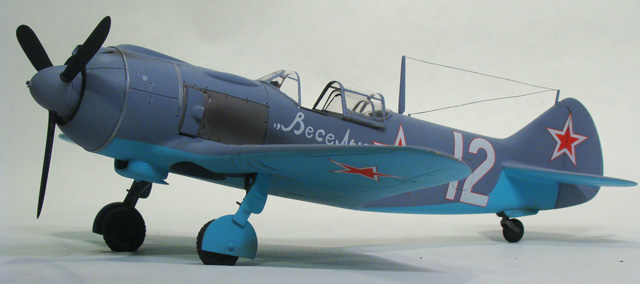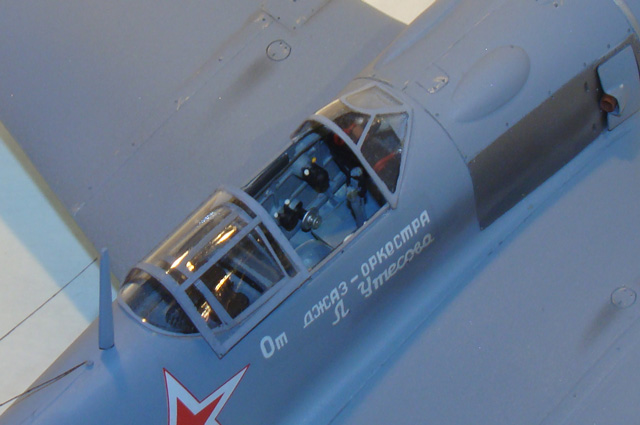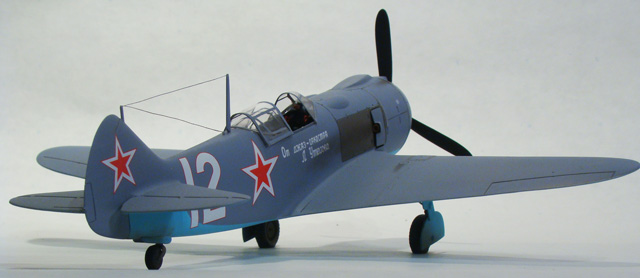Vector Resin's 1/48 scale
Lavochkin La-5F
by Gregory T. Conterio
|

|
Lavochkin La-5F |

Hobby Boss' 1/48 scale F-111C is available online from Squadron.com
The La-5F was in incremental improvement in the Lavochkin La-5 series, which ultimately culminated in the La-9 and 11 of the post-war period. In order to tell the story of the La-5, one needs to take a step back to 1940, when the Powers that Be in the Soviet Union held something of a “competition” for a new fighter to replace the I-16. The LaGG-3 was one of three new fighter designs selected as the “winners” of this contest, the other two being the Yak-1 and the MiG-3. The Soviet method of selecting and developing fighter designs was very different than in the West, with politics playing as great a role as any other factor in the process. Production orders were placed often with a new design having had little more than one or two initial test flights, and the unbelievable pressure placed on factories to meet production quotas resulted in quite predictable quality problems and serious construction flaws. Developing a particular design to the point where it was reliable and reasonably safe was often an act of will, and the toll it took on combat pilots due to such flaws was accepted to a far greater degree than in the West. Such was the case with the underpowered LaGG-3.
If one were to compose a list of the blue-bloods among WWII aircraft engines, I don’t think you would be finding the Mikulin AM-35/38, or the Klimov M-105 among them. Yet these were the two principle water-cooled inline engines employed by the Soviets throughout the war. The Soviet 12-cylinder inline engines were generally heavier, and produced less horsepower than their contemporaries in American, Germany and Great Britain. What’s more, while development in Germany, Great Britain and America produced newer, more advanced models with ever more impressive output, the basic Soviet models changed little throughout the war. When one cannot increase the performance output of one’s power plant, one option is to try to refine the airframe as much as possible, making it lighter and smaller. This was the path followed by Yakovlev, whose fighters were powered by various versions of the M-105 (Also known as the VK-105) engine, and ultimately resulted in the very good Yak-3. Another option is to simply find another engine, and this is what Lavochkin finally did, with the La-5 entering production in 1942, and dramatically improving the performance of the LaGG-3 airframe.

While Soviet inline engines were relatively poor compared to their contemporaries, their radial engines were the opposite. There has been a rather self-serving claim for many years that the Soviets merely copied American and German radial engine designs, but this is untrue. The Shvetsov M-82 was a wholly Soviet development, and had an excellent power to weight ratio. The engine had been ordered in quantity for the Sukhoi Su-2 and Tupolev Tu-2 bombers, neither of which was ready for production, so there was something of a surplus of them sitting around in 1941. (Feel free to insert your own deprecatory comment about the Soviet system of procurement and production in time of war...) The challenge was in grafting one of these 1,260mm diameter engines onto a fuselage that was only 800mm wide. It was really something of a serendipitous partnership, with Arkadyi Shvetsov nervously sitting on a pile of unused engines, and Lavochkin faced with a very unhappy government demanding immediate improvement in an underpowered fighter derisively called “clumsy goose” and “guaranteed varnished coffin” by many pilots. When one considers the political environment, where many honest, talented and patriotic engineers were being arrested or executed as enemies of the state, sometimes for simply doing exactly as their government demanded, one can imagine just how relieved and delighted Shvetsov and Lavochkin were when the first LaGG-3 with an M-82 engine performed so brilliantly!
In addition to correcting quality and production flaws, Lavochkin continued developing the La-5, and in 1942 had perfected the implementation of the improved M-82F engine. Lavochkin had also been working on fuselage changes to save weight and improve the all-around view of the pilot. These improvements together formed the Type 39, better-known as the La-5F, and which entered production in the end of that year.
As far as I know, the Vector kit is the only representation of the 5F version of the Lavochkin in 1/48th scale. Although they’re really pricey, the Vector kits are all pretty spectacular when it comes to quality, engineering and level of detail.
The only thing I replaced was the main wheels. The kit comes with a set of Equipage rubber-tired wheels which I just didn’t care for, so I ordered True Details resin wheels for all my Vector Lavochkins. (Yep, I got them all. Please don’t tell my wife!)

The cockpit is an amazing collection of detail, and when completed looks just stunning, right out of the box. My only addition was the armored glass that was mounted behind the pilot’s head.
Other than that, it’s entirely stock. The only real challenge was fitting the rear portion of the canopy, which never quite mated up with the fuselage correctly.
Soviet wartime colors have always been a controversial topic, and only became more so over the past few years with the discovery of a paint standards document dating from the period, and including color chip samples. There has been a good deal of debate, not all of it civil, over how important this document actually is. To be perfectly honest, I find some of the criticism of it to be valid. There is however a new line of paint from a Russian company called AKAN based on the color chips in this document. Having looked at the color interpretations, I have not really decided if this really represents “The Truth” in Soviet wartime colors, nor if it should replace traditional interpretations. With my Lavochkin, tradition won out. Experimentation will have to wait, and perhaps involve a kit that isn’t in the $90+ price category!
Finding markings in 1/48 scale for the La-5F can be a bit of a challenge, but I managed to get a hold of the excellent sheet by Avalon for the La-5F/FN released a couple years ago. AML also have some nice-looking, if pricey decal sheets with markings for the type. I selected the relatively simple but striking markings of White 12 from the Avalon sheet, in overall AMT-11 with AMT-7 undersides. The paint is PollyScale, custom-mixed, but based on USSR Underside Blue and Haze Gray. Weathering is light, due to the simple fact that I like it that way!
There has been a veritable explosion of 1/48 scale WWII Lavochkin kits over the past few years, but we have yet to see an injection-molded La-5F. Short of doing a kit-bash or a conversion, the Vector offering is still the only game in town. On the plus side, it is a really wonderful kit. I don’t think you will find anyone doing better resin kits, and if you are not deterred by the high price, you will likely be very happy with Vector.
Model and Text Copyright ©
2011 by Gregory T. Conterio
Page Created 1 August, 2011
Last Updated
1 August, 2011
Back to
HyperScale Main Page

|
Home
| What's New |
Features |
Gallery |
Reviews |
Reference |
Forum |
Search